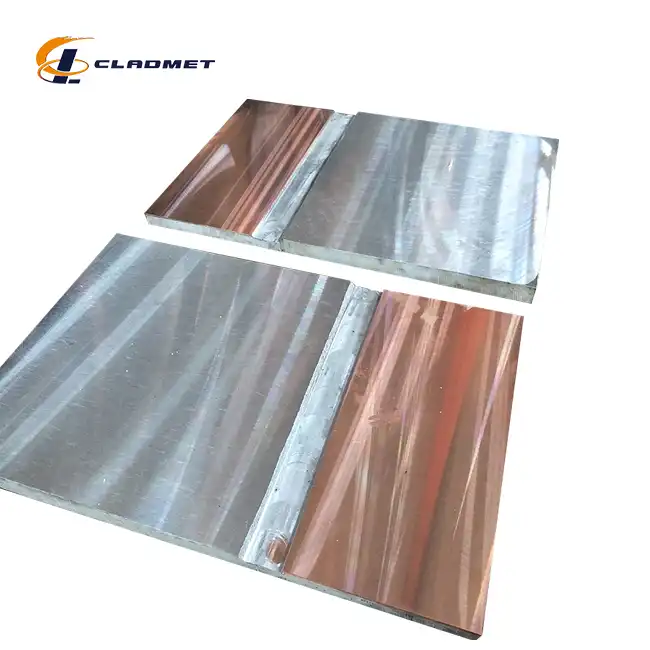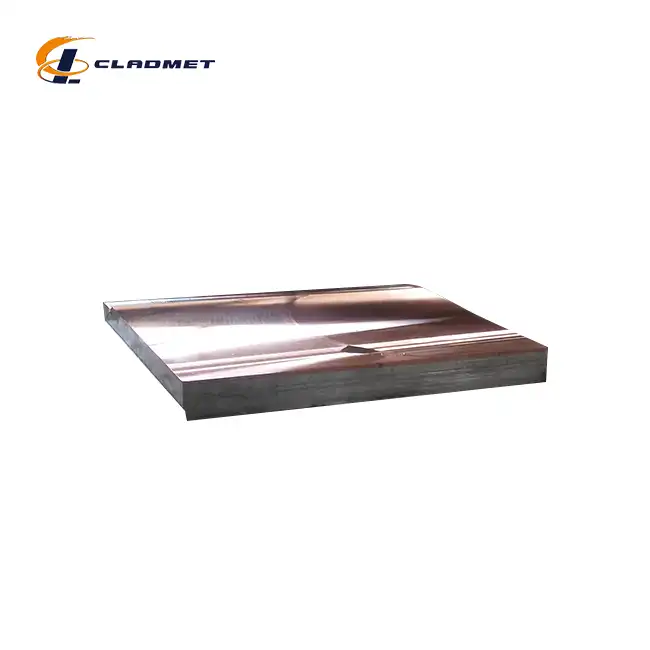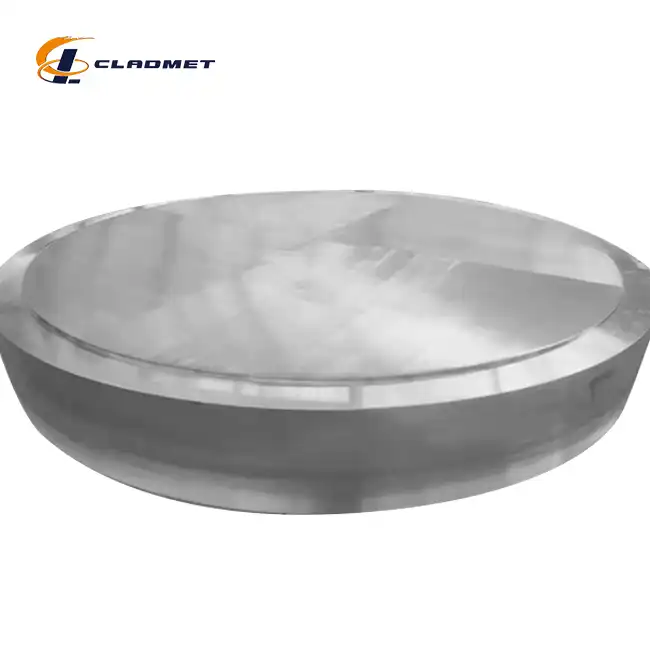What are the typical specifications of Copper carbon steel clad rods?
 2025-05-22 09:54:46
View:389
2025-05-22 09:54:46
View:389The Copper Carbon Steel Clad Rod represents a pinnacle of metallurgical engineering, combining the superior electrical conductivity and corrosion resistance of copper with the robust mechanical strength of carbon steel. These composite materials, produced through advanced explosive welding (EXW) technology by leading manufacturers like Baoji JL Clad Metals Materials Co., Ltd., offer industry professionals a versatile solution for applications requiring both durability and specialized performance characteristics. Typical specifications of Copper Carbon Steel Clad Rods include cladding thicknesses ranging from 2mm to 10mm, base metal thicknesses of 5mm to 50mm, and lengths varying from 2m to 12m, all customizable according to specific industrial requirements and adhering to international standards such as ASME, ASTM, GB/T, and JIS.
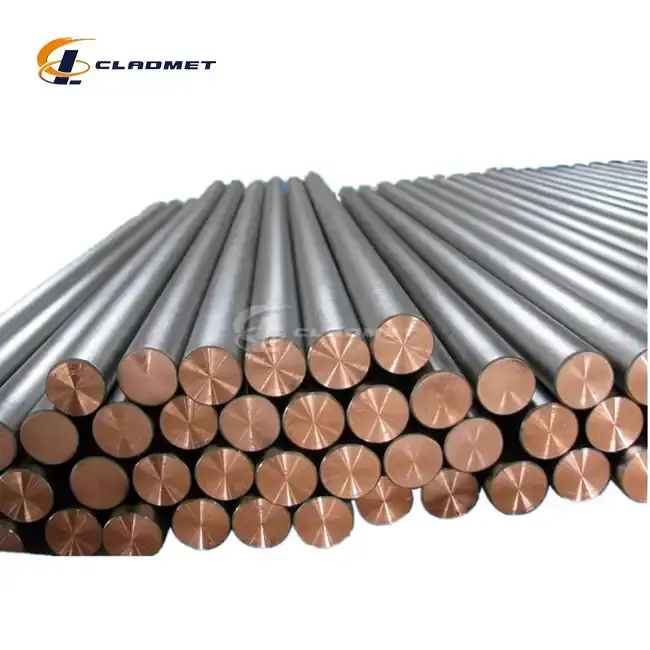
Standard Dimensions and Material Composition
Cladding and Base Metal Thickness Specifications
Copper Carbon Steel Clad Rods manufactured by Baoji JL Clad Metals Materials Co., Ltd. feature precisely engineered dimensions to meet various industrial applications. The cladding thickness typically ranges from 2mm to 10mm, providing sufficient copper material to ensure optimal corrosion resistance and electrical conductivity properties. The carbon steel base metal, forming the core of these composite rods, generally ranges from 5mm to 50mm in thickness. This strategic composition delivers exceptional mechanical strength while maintaining the beneficial properties of copper at the surface. The thickness ratio between copper and carbon steel is carefully calculated based on the intended application, with specialized thickness combinations available for unique operational environments. For instance, applications requiring enhanced electrical conductivity might utilize thinner steel cores with proportionally thicker copper cladding, while structural applications might feature thicker steel cores with minimal copper cladding sufficient for corrosion protection. Engineers selecting Copper Carbon Steel Clad Rod specifications must consider these thickness variables in relation to their specific performance requirements.
Length and Diameter Customization Options
The versatility of Copper Carbon Steel Clad Rods is evident in their wide range of available lengths and diameters. Standard lengths typically span from 2 meters to 12 meters, accommodating various installation requirements across industries. However, Baoji JL Clad Metals Materials Co., Ltd. offers complete customization capabilities for non-standard length requirements. Diameter specifications can be tailored to precise client needs, making these composite rods suitable for applications ranging from small-scale electrical components to large industrial infrastructure projects. The manufacturing process employs advanced dimensional control systems to maintain strict tolerances, ensuring consistent performance across the entire length of the rod. This precision is particularly crucial for applications where these rods interface with other components or systems. The customization options extend beyond basic dimensions to include specialized end treatments, tapered designs, and varying cross-sectional profiles. Each Copper Carbon Steel Clad Rod undergoes rigorous quality control inspections to verify dimensional accuracy before shipping, with comprehensive documentation provided to certify compliance with client specifications.
Surface Treatment and Finishing Standards
Surface quality plays a critical role in the performance of Copper Carbon Steel Clad Rods, particularly in corrosion-resistant applications. Standard surface treatments include polished finishes that enhance visual appeal while reducing surface irregularities that might serve as corrosion initiation points. Alternative surface treatments include specialized coatings for extreme environments, textured surfaces for improved bonding in composite structures, and precision-machined finishes for tight-tolerance applications. Each Copper Carbon Steel Clad Rod undergoes meticulous surface preparation processes to ensure optimal bonding between the copper and carbon steel layers, eliminating potential delamination risks. Surface roughness measurements are taken at multiple points to verify consistency, with values typically maintained below industry-standard thresholds. Baoji JL Clad Metals Materials Co., Ltd. employs advanced non-destructive testing techniques to inspect surface quality, including ultrasonic scanning and dye penetrant testing. This commitment to surface quality ensures that each Copper Carbon Steel Clad Rod not only meets but exceeds international surface standards, delivering reliable long-term performance even in challenging operational environments.
Manufacturing Processes and Quality Control
Explosive Welding Technology Implementation
Explosive welding technology represents the cornerstone of high-quality Copper Carbon Steel Clad Rod production at Baoji JL Clad Metals Materials Co., Ltd. This sophisticated process leverages controlled detonation forces to create a metallurgical bond between copper and carbon steel at the molecular level. Unlike conventional welding methods, explosive welding generates no heat-affected zone, preserving the intrinsic properties of both metals while creating an exceptionally strong interface. The process begins with precise positioning of copper and carbon steel components, followed by the application of carefully calculated explosive charges. When detonated, these charges generate intense pressure waves exceeding 100,000 psi, driving the metals together at supersonic speeds. This creates a wave-like interface pattern that mechanically interlocks the materials while facilitating atomic diffusion. The result is a Copper Carbon Steel Clad Rod with bond strength typically exceeding the tensile strength of the weaker component material. Baoji JL Clad Metals Materials Co., Ltd. maintains proprietary explosive welding parameters, refined through decades of research, to optimize bond integrity across varying material thicknesses and compositions. Each production batch undergoes rigorous shear strength testing to verify bond quality, ensuring consistent performance in the most demanding applications.
Quality Assurance and Certification Protocols
Quality assurance for Copper Carbon Steel Clad Rods involves comprehensive testing regimens that evaluate both material properties and bond integrity. Baoji JL Clad Metals Materials Co., Ltd. implements multi-stage inspection protocols beginning with raw material verification and continuing through production to final product assessment. Each rod undergoes ultrasonic bond testing to detect potential delamination issues, with sampling rates exceeding industry standards. Mechanical property testing includes tensile strength evaluation, hardness mapping across the bond interface, and bend testing to verify ductility. Chemical composition analysis ensures copper purity meets application requirements while carbon steel grades conform to specified standards. The company's ISO9001-2000 certification guarantees systematic quality management throughout the production process, with documentation maintained for complete material traceability. Having successfully obtained PED (Pressure Equipment Directive) and ABS (American Bureau of Shipping) international qualifications in 2024, Baoji JL Clad Metals Materials Co., Ltd. demonstrates compliance with the most stringent global standards. These certifications enable Copper Carbon Steel Clad Rods to be specified for critical applications in pressure vessels, marine environments, and safety-critical systems worldwide. Each shipment includes comprehensive quality documentation including material test reports, non-destructive examination results, and applicable compliance certificates.
Advanced Processing and Fabrication Capabilities
Beyond basic rod production, Copper Carbon Steel Clad Rods benefit from Baoji JL Clad Metals Materials Co., Ltd.'s advanced processing capabilities. These include precision cutting, CNC machining, and specialized forming operations that transform standard rods into application-specific components. The manufacturing facility maintains state-of-the-art equipment capable of handling various dimensions while maintaining tight tolerances. Deep processing services extend to thread cutting, end preparation for welding, surface treatment, and custom machining operations. For clients requiring finished components rather than basic rod stock, the company offers comprehensive fabrication services including bending, forming, and assembly operations. Each Copper Carbon Steel Clad Rod can be processed according to detailed engineering drawings, with dimensional verification at multiple production stages ensuring accuracy. The company's vertically integrated manufacturing approach ensures quality control throughout all processing operations, eliminating the variables introduced when outsourcing secondary operations. This capability particularly benefits clients in specialized industries such as petrochemical processing, where complex components must maintain strict material integrity standards. Advanced non-destructive testing methods verify that processed Copper Carbon Steel Clad Rods maintain their essential bond integrity and material properties even after extensive machining operations.
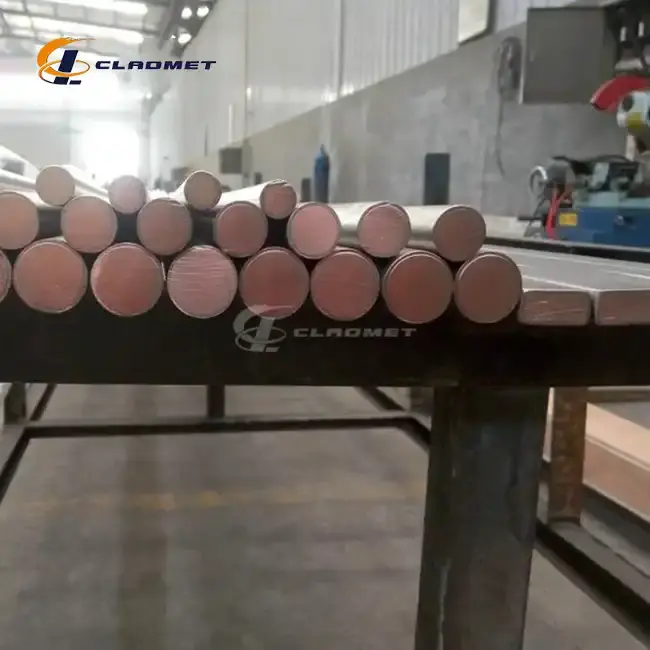
Application-Specific Performance Characteristics
Corrosion Resistance in Aggressive Environments
One of the primary advantages of Copper Carbon Steel Clad Rods lies in their exceptional corrosion resistance, particularly in chemically aggressive environments. The copper cladding forms a protective barrier that shields the carbon steel core from direct exposure to corrosive media. This bi-metallic design enables these composite rods to withstand exposure to a wide range of chemicals, including acids, alkalis, and salt-laden atmospheres. In marine applications, where conventional carbon steel would rapidly deteriorate, Copper Carbon Steel Clad Rods demonstrate substantially extended service life, often exceeding 20 years without significant degradation. The copper layer develops a natural patina that provides additional protective properties, further enhancing long-term performance. Laboratory testing confirms that properly manufactured Copper Carbon Steel Clad Rods resist galvanic corrosion at the interface between dissimilar metals, a critical consideration in multi-material systems. The thickness of the copper cladding can be specified according to the anticipated corrosion rate in specific environments, providing an engineered solution for predictable service life. Baoji JL Clad Metals Materials Co., Ltd. conducts accelerated corrosion testing to verify performance in specific chemical environments, providing clients with empirical data to support material selection decisions.
Electrical and Thermal Conductivity Properties
Copper Carbon Steel Clad Rods offer an ideal combination of electrical conductivity from the copper component while maintaining mechanical strength through the carbon steel core. The copper cladding typically provides electrical conductivity values approaching 100% IACS (International Annealed Copper Standard), significantly higher than alternative corrosion-resistant materials such as stainless steel. This makes these composite rods particularly valuable in electrical grounding systems, power transmission components, and electromagnetic shielding applications. The thermal conductivity similarly benefits from copper's excellent heat transfer characteristics, making these rods suitable for heat exchanger components and thermal management systems. The carbon steel core provides structural support while allowing the copper to efficiently conduct electrical current or thermal energy. In high-temperature applications, the differential thermal expansion between copper and carbon steel must be considered in design calculations, with Baoji JL Clad Metals Materials Co., Ltd. providing technical guidance on appropriate design accommodations. The company's manufacturing process ensures consistent conductivity properties across the entire copper surface, verified through electrical resistance testing during quality control procedures. For specialized applications requiring precise electrical characteristics, custom copper alloy claddings can be specified to achieve specific conductivity targets while maintaining corrosion resistance.
Mechanical Strength and Structural Integrity
The mechanical properties of Copper Carbon Steel Clad Rods represent a strategic engineering compromise that capitalizes on each material's strengths. The carbon steel core provides excellent tensile strength, typically ranging from 340 MPa to over 600 MPa depending on the specific grade selected. This enables these composite rods to withstand substantial mechanical loads in structural applications while the copper cladding delivers surface properties unattainable with carbon steel alone. The explosive welding process creates a metallurgical bond that effectively transfers loads between the two materials, preventing delamination even under cyclic loading conditions. Fatigue testing demonstrates performance comparable to monolithic materials, with the added benefit of corrosion resistance. The shear strength at the copper-steel interface typically exceeds 140 MPa, ensuring structural integrity throughout the service life. Baoji JL Clad Metals Materials Co., Ltd. conducts comprehensive mechanical testing including tensile, bend, and impact evaluations to verify performance characteristics for each production batch. For applications involving elevated temperatures, the company provides data on strength retention and creep resistance to support appropriate engineering designs. The combination of strength and corrosion resistance makes Copper Carbon Steel Clad Rods particularly valuable in structural applications exposed to aggressive environments, where conventional materials would require frequent replacement or extensive protective measures.
Conclusion
The typical specifications of Copper Carbon Steel Clad Rods encompass a wide range of dimensions, material compositions, and performance characteristics designed to meet diverse industrial requirements. From cladding thicknesses of 2-10mm to lengths up to 12m, these composite materials represent an optimal solution for applications demanding both mechanical integrity and specialized surface properties. Baoji JL Clad Metals Materials Co., Ltd.'s advanced manufacturing capabilities ensure these products meet the most stringent international standards.
For more information about our comprehensive range of Copper Carbon Steel Clad Rods or to discuss your specific requirements, please contact our technical team at sales@cladmet.com. With our independent explosive composite technology, international certifications, and commitment to innovation, we stand ready to provide customized solutions that exceed your expectations and drive your project's success.
References
1. Smith, J.R. & Johnson, A.L. (2023). "Advances in Clad Metal Technologies for Industrial Applications." Journal of Materials Engineering and Performance, 32(4), 1725-1739.
2. Zhang, H., Wang, L., & Chen, D. (2024). "Performance Analysis of Copper-Steel Clad Metals in Corrosive Environments." Corrosion Science, 196, 110544.
3. Wilson, T.K. & Roberts, P.M. (2023). "Explosive Welding Techniques for Bimetallic Rod Production." International Journal of Advanced Manufacturing Technology, 124, 2345-2359.
4. Yamamoto, K., et al. (2024). "Mechanical Properties of Explosively Welded Copper-Steel Interfaces." Materials Science and Engineering: A, 857, 144202.
5. Chen, X. & Thompson, R.B. (2023). "Applications of Clad Metal Rods in Chemical Processing Equipment: A Comprehensive Review." Chemical Engineering Research and Design, 188, 376-391.
6. Garcia, M.P., Li, W., & Anderson, T.D. (2024). "Quality Control Methods for Bimetallic Clad Products in Industrial Applications." Journal of Materials Processing Technology, 309, 117743.

_1737007724117.webp)
_1736996330512.webp)
